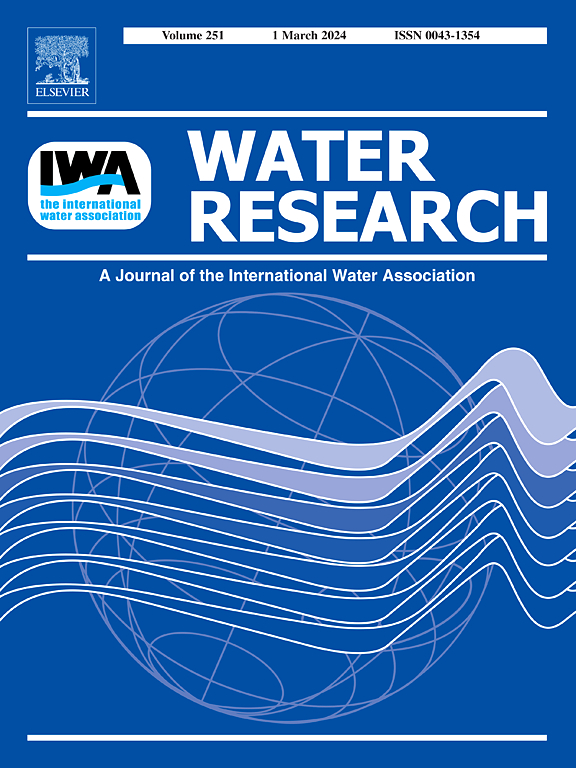Trade-offs in microplastic-adsorbed iopamidol degradation by UV-AOPs: Molecular-level insights into deiodination pathways versus iodinated disinfection by-products formation
IF 12.4
1区 环境科学与生态学
Q1 ENGINEERING, ENVIRONMENTAL
引用次数: 0
Abstract
The divergent transformation pathways of iopamidol (IPM) adsorbed on polyethersulfone microplastics (PES-MPs) during UV/chlorine (UV/Cl2) and UV/peracetic acid (UV/PAA) treatments were elucidated in this study. Molecular-level trade-offs between degradation efficiency and disinfection byproducts (DBPs) toxicity were unraveled through fourier-transform ion cyclotron resonance mass spectrometry (FT-ICR-MS) analysis. Radical-mediated cleavage of aromatic C-I bonds was predominantly observed in UV/Cl2 process, yielding low-molecular weight chlorinated aliphatics (300–500 Da). While iodine retention and polyiodination were promoted through carbon-centered radicals-mediated decarboxylation in UV/PAA process. IPM degradation involved the deiodination, amide hydrolysis, and amino oxidation, yielding intermediates and DBPs precursors (such as TP-274.5, TP-91.5). The formation of chlorinated-DBPs (Cl-DBPs) was predominantly driven by electrophilic substitution mechanisms involving MPs-DOM under UV/Cl2 treatment. In contrast, the iodinated-DBPs (I-DBPs) exhibited significant accumulation (601.06 μg/L) during UV/PAA treatment, particularly polyiodinated aromatic compounds such as C11H12N5OI, attributed to sequential deiodination and reiodination pathways. Excitation-emission matrix-parallel factor analysis (EEM-PARAFAC) and FT-ICR-MS analyses revealed the enhanced aromatic oxygenation (O/C ratio 0.3–0.5) in UV/Cl2 process, while stable iodinated intermediates accumulated during UV/PAA treatment. Mass difference analysis identified 33 reaction types, with hydroxylation (+1O) prevailing in UV/Cl2 system and polyiodination (+2I-2H) dominating in UV/PAA system. Toxicity assessments predicted two- to three-fold higher chronic risks associated with mixed Cl-/I-DBPs compared to the parent compound IPM, underscoring the necessity to balance degradation efficacy with DBPs control in systems contaminated with MPs. This study provides mechanistic insights for optimizing advanced oxidation processes in complex water matrices.
微塑料吸附的碘帕美醇降解的权衡:分子水平上对脱碘途径与碘化消毒副产物形成的见解
研究了UV/氯(UV/Cl2)和UV/过氧乙酸(UV/PAA)处理下,iopamidol (IPM)吸附在聚醚砜微塑料(PES-MPs)上的不同转化途径。通过傅里叶变换离子回旋共振质谱(FT-ICR-MS)分析,揭示了降解效率和消毒副产物(DBPs)毒性之间的分子水平权衡。自由基介导的芳香族C-I键裂解主要发生在UV/Cl2过程中,生成低分子量的氯化脂肪族(300-500 Da)。而在UV/PAA过程中,碳中心自由基介导的脱羧作用促进了碘的保留和多碘化。IPM降解包括脱碘、酰胺水解和氨基氧化,生成中间体和dbp前体(如TP-274.5, TP-91.5)。氯代dbps (Cl-DBPs)的形成主要由UV/Cl2处理下涉及MPs-DOM的亲电取代机制驱动。相比之下,在UV/PAA处理过程中,碘化dbps (I-DBPs)表现出显著的积累(601.06 μg/L),特别是多碘芳香族化合物,如C11H12N5OI,由于顺序的脱碘和再碘途径。激发-发射矩阵-平行因子分析(EEM-PARAFAC)和FT-ICR-MS分析表明,UV/Cl2处理增强了芳香族氧化(O/C比0.3 ~ 0.5),而稳定的碘化中间体在UV/PAA处理过程中积累。质量差分析鉴定出33种反应类型,其中UV/Cl2体系以羟基化反应(+ 10o)为主,UV/PAA体系以多碘化反应(+2I-2H)为主。毒性评估预测,与母体化合物IPM相比,混合Cl-/I-DBPs的慢性风险要高出两到三倍,这强调了在被MPs污染的系统中平衡降解效率和DBPs控制的必要性。该研究为优化复杂水基质中的高级氧化过程提供了机制见解。
本文章由计算机程序翻译,如有差异,请以英文原文为准。
求助全文
约1分钟内获得全文
求助全文
来源期刊

Water Research
环境科学-工程:环境
CiteScore
20.80
自引率
9.40%
发文量
1307
审稿时长
38 days
期刊介绍:
Water Research, along with its open access companion journal Water Research X, serves as a platform for publishing original research papers covering various aspects of the science and technology related to the anthropogenic water cycle, water quality, and its management worldwide. The audience targeted by the journal comprises biologists, chemical engineers, chemists, civil engineers, environmental engineers, limnologists, and microbiologists. The scope of the journal include:
•Treatment processes for water and wastewaters (municipal, agricultural, industrial, and on-site treatment), including resource recovery and residuals management;
•Urban hydrology including sewer systems, stormwater management, and green infrastructure;
•Drinking water treatment and distribution;
•Potable and non-potable water reuse;
•Sanitation, public health, and risk assessment;
•Anaerobic digestion, solid and hazardous waste management, including source characterization and the effects and control of leachates and gaseous emissions;
•Contaminants (chemical, microbial, anthropogenic particles such as nanoparticles or microplastics) and related water quality sensing, monitoring, fate, and assessment;
•Anthropogenic impacts on inland, tidal, coastal and urban waters, focusing on surface and ground waters, and point and non-point sources of pollution;
•Environmental restoration, linked to surface water, groundwater and groundwater remediation;
•Analysis of the interfaces between sediments and water, and between water and atmosphere, focusing specifically on anthropogenic impacts;
•Mathematical modelling, systems analysis, machine learning, and beneficial use of big data related to the anthropogenic water cycle;
•Socio-economic, policy, and regulations studies.
 求助内容:
求助内容: 应助结果提醒方式:
应助结果提醒方式:


